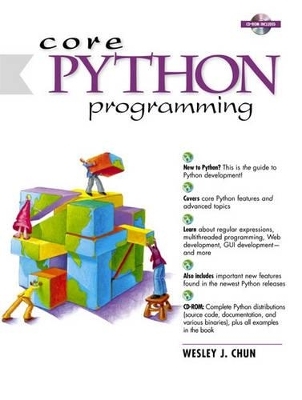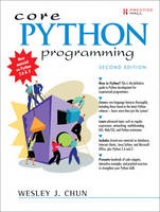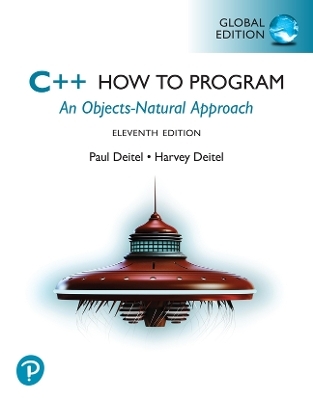
Core Python Programming
Prentice Hall
978-0-13-026036-9 (ISBN)
- Titel erscheint in neuer Auflage
- Artikel merken
Python is soaring in popularity, and it's no wonder: Python is fast, scalable, easy to learn, and combines the best aspects of scripting languages like Perl with the key advantages of object languages like Java. In this book, Yahoo! Internet software engineer Wesley Chun teaches experienced developers all they need to know to leverage all of Python's power -- fast. Like all Core Series books, Core Python Programming teaches via hundreds of industrial-strength code examples, all targeted at professional developers who want to leverage the skills they already have. Chun begins with a professional-level introduction to Python syntax, objects, and error handling; functions, classes, and built-ins. Learn the best techniques for handling I/O, manipulating Python objects, working with files, filesystems, and more. Core Python Programming delivers detailed real-world coverage of Web/Internet and network programming, including CGI applications, adding Python support to web servers, client/server applications, network I/O, encryption/decryption, integration with DBM databases, and much more. The book also contains a quick reference to the entire language.
WESLEY J. CHUN holds computer science and mathematics degrees from the University of CA, MSCS from U.C. Santa Barbara, and an AB in Mathematics and Minor in Music. He is a principal consultant at Cyberweb Consulting. While at Yahoo!, Chun used Python to help create Yahoo!Mail and Yahoo! People Search. Chun has over 18 years of UNIX, computer programming, and instructional experience. In his spare time, Chun serves as a technical instructor with U.C. Santa Cruz where he teaches Python, C, and UNIX for the UCSC Extension system.
I. CORE PYTHON.
1. WELCOME TO PYTHON!
What Is Python? History of Python. Features of Python. Obtaining Python. Obtaining Python. Installing Python. Running Python. Python Documentation. Comparing Python. JPython and Some Nomenclature. Exercises.
2. GETTING STARTED.
Program Output, the print Statement, and "Hello World!" Program Input and the raw_input() Built-in Function. Comments. Operators. Variables and Assignment. Numbers. Strings. Lists and Tuples. Dictionaries. Code Blocks Use Indentation. if Statement. while Loop. for Loop and the range() Built-in Function. Files and the open() Built-in Function. Errors and Exceptions. Functions. Classes. Modules. Exercises.
3. SYNTAX AND STYLE.
Statements and Syntax. Variable Assignment. Identifiers. Basic Style Guidelines. Memory Management. First Python Application. Exercises.
4. PYTHON OBJECTS.
Python Objects. Standard Types. Other Built-in Types. Internal Types. Standard Type Operators. Standard Type Built-in Functions. Categorizing the Standard Types. Unsupported Types. Exercises.
5. NUMBERS.
Introduction to Numbers. Integers. Floating Point Real Numbers. Complex Numbers. Operators. Built-in Functions. Related Modules. Exercises.
6. SEQUENCES: STRINGS, LISTS, AND TUPLES.
Sequences. Strings. Strings and Operators. String-only Operators. Built-in Functions. String Built-in Methods. Special Features of Strings. Related Modules. Summary of String Highlights. Lists. Operators. Built-in Functions. List Type Built-in Methods. Special Features of Lists. Tuples. Tuple Operators and Built-in Functions. Special Features of Tuples. Related Modules. *Shallow and Deep Copies. Exercises.
7. DICTIONARIES.
Introduction to Dictionaries. Operators. Built-in Functions. Built-in Methods. Dictionary Keys. Exercises.
8. CONDITIONALS AND LOOPS.
if statement. else Statement. elif (a.k.a else-if) Statement. while Statement. for Statement. break Statement. continue Statement. pass Statement. else Statement Take Two. Exercises.
9. FILES AND INPUT/OUTPUT.
File Objects. File Built-in Function [open()]. File Built-in Methods. File Built-in Attributes. Standard Files. Command-line Arguments. File System. File Execution. Persistent Storage Modules. Related Modules. Exercises.
10. ERRORS AND EXCEPTIONS.
What Are Exceptions? Exceptions in Python. Detecting and Handling Exceptions. *Exceptions as Strings. *Exceptions as Classes. Raising Exceptions. Assertions. Standard Exceptions. *Creating Exceptions. Why Exceptions (Now)? Why Exceptions at All? Exceptions and the sys Module. Related Modules. Exercises.
11. FUNCTIONS.
What are Functions? Calling Functions. Creating Functions. Passing Functions. Formal Arguments. Variable-length Arguments. Functional Programming. Variable Scope. *Recursion. Exercises.
12. MODULES.
What are Modules? Modules and Files. Namespaces. Importing Modules. Importing Module Attributes. Module Built-in Functions. Packages. Other Features of Modules. Exercises.
13. CLASSES AND OOP.
Introduction. Object-oriented Programming. Classes. Class Attributes. Instances. Instance Attributes. Binding and Method Invocation. Composition. Subclassing and Derivation. Inheritance. Built-in Functions for Classes, Instances, and Other Objects. Type vs Classes/Instances. Customizing Classes with Special Methods. Privacy. Delegation. Related Modules and Documentation. Exercises.
14. EXECUTION ENVIRONMENT.
Callable Objects. Code Objects. Executable Object Statements and Built-in Functions. Executing Other (Python) Programs. Executing Other (Non-Python) Programs. Restricted Execution. Terminating Execution. Related Modules. Exercises.
II. ADVANCED TOPICS.
15. REGULAR EXPRESSIONS.
Introduction/Motivation. Special Symbols and Characters for REs. REs and Python. Regular Expression Adventures. Exercises.
16. NETWORK PROGRAMMING.
Introduction. Sockets: Communication Endpoints. Network Programming in Python. Related Modules. Exercises.
17. MULTITHREADED PROGRAMMING.
Introduction/Motivation. Threads and Processes. Threads and Python. thread Module. threading Module. Exercises.
18. GUI PROGRAMMING WITH TKINTER.
Introduction. Tkinter and Python Programming. Tkinter Examples. Related Modules and Other GUIs. Exercises.
19. WEB PROGRAMMING.
Introduction. Web Surfing with Python: Creating Simple Web Clients. Advanced Web Clients. CGI: Helping Web Servers Process Client Data. Building CGI Application. Advanced CGI. Web (HTTP) Servers. Related Modules. Exercises.
20. EXTENDING PYTHON.
Introduction/Motivation. Extending Python by Writing Extensions. Related Topics. Exercises. Answers to Selected Exercises. Other Reading and References. Other Printed References. Online References. Python Operator Summary. What's New in Python 2.0?
Appendix A.
Appendix B.
Appendix C.
Appendix D.
Index.
About the Author.
| Erscheint lt. Verlag | 27.12.2000 |
|---|---|
| Verlagsort | Upper Saddle River |
| Sprache | englisch |
| Gewicht | 1578 g |
| Themenwelt | Mathematik / Informatik ► Informatik ► Programmiersprachen / -werkzeuge |
| ISBN-10 | 0-13-026036-3 / 0130260363 |
| ISBN-13 | 978-0-13-026036-9 / 9780130260369 |
| Zustand | Neuware |
| Informationen gemäß Produktsicherheitsverordnung (GPSR) | |
| Haben Sie eine Frage zum Produkt? |
aus dem Bereich

